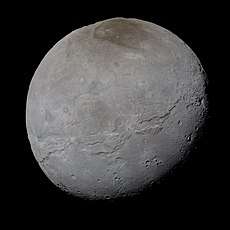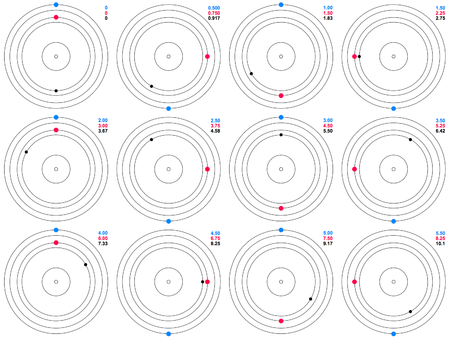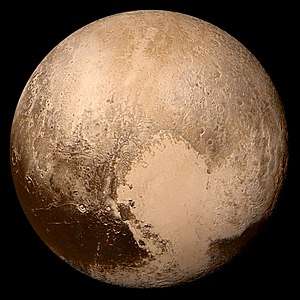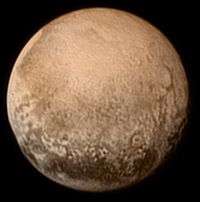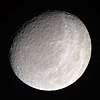Moons of Pluto
| |||
(Images not to scale) |
The dwarf planet Pluto has five moons down to a detection limit of about 1 km in diameter. In order of distance from Pluto, they are Charon, Styx, Nix, Kerberos, and Hydra.[1] Charon, the largest of the five moons, is mutually tidally locked with Pluto, and is massive enough that Pluto–Charon is sometimes considered a double dwarf planet.
History
The innermost and largest moon, Charon, was discovered by James Christy on 22 June 1978, nearly half a century after Pluto was discovered. This led to a substantial revision in estimates of Pluto's size, which had previously assumed that the observed mass and reflected light of the system were all attributable to Pluto alone.
Two additional moons were imaged by astronomers of the Pluto Companion Search Team preparing for the New Horizons mission and working with the Hubble Space Telescope on 15 May 2005, which received the provisional designations S/2005 P 1 and S/2005 P 2. The International Astronomical Union officially named these moons Nix (or Pluto II, the inner of the two moons, formerly P 2) and Hydra (Pluto III, the outer moon, formerly P 1), on 21 June 2006.[2] Kerberos, announced on 20 July 2011, was discovered while searching for Plutonian rings. Styx, announced on 7 July 2012, was discovered while looking for potential hazards for New Horizons.[3]

Charon
Charon is about half the diameter of Pluto and is so massive (nearly one eighth of the mass of Pluto) that the system's barycenter lies between them, approximately 960 km above Pluto's surface.[4][lower-alpha 1] Charon and Pluto are also tidally locked, so that they always present the same face toward each other. The IAU General Assembly in August 2006 considered a proposal that Pluto and Charon be reclassified as a double planet, but the proposal was abandoned.[5]
Small moons
.jpg)
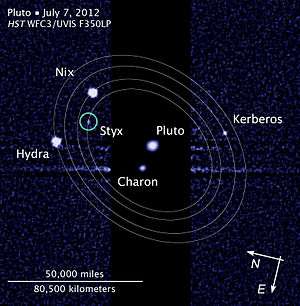
Pluto's four small moons orbit Pluto at two to four times the distance of Charon, ranging from Styx at 42,700 kilometres to Hydra at 64,800 kilometres from the barycenter of the system. They have nearly circular prograde orbits in the same orbital plane as Charon.
All are much smaller than Charon. Nix and Hydra, the two larger, are roughly 42 and 55 kilometers on their longest axis respectively,[6] and Styx and Kerberos are 7 and 12 kilometers respectively.[7][8] All four are irregularly shaped.
Characteristics

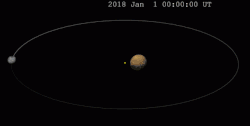
The Pluto system is highly compact and largely empty.[9] Moons could potentially orbit Pluto at up to 53% (or 69%, if retrograde) of the Hill radius, the stable gravitational zone of Pluto's influence.[10] For example, Psamathe orbits Neptune at 40% of the Hill radius. In the case of Pluto, only the inner 3% of the region where prograde orbits would be stable is occupied by satellites,[9] and the region from Styx to Hydra is packed so tightly that there is little room for further moons with stable orbits.[11] An intense search conducted by New Horizons confirmed that no moons larger than 4.5 km in diameter exist at the distances up to 180,000 km from Pluto (for smaller distances, this threshold is still smaller).[12]
The orbits of the moons are confirmed to be circular and coplanar, with inclinations differing less than 0.4° and eccentricities less than 0.005.[13]
The discovery of Nix and Hydra suggested that Pluto could have a ring system. Small-body impacts can create debris that can form into a ring system. However, data from a deep-optical survey by the Advanced Camera for Surveys on the Hubble Space Telescope, by occultation studies,[14] and later by New Horizons, suggest that no ring system is present.
Resonances
Styx, Nix, and Hydra are thought to be in a 3-body orbital resonance with orbital periods in a ratio of 18:22:33; the respective ratio of orbits is 11:9:6.[15][16] The ratios should be exact when orbital precession is taken into account. Hydra and Nix are in a simple 2:3 resonance.[lower-alpha 2][15][17] Styx and Nix are in a 11:9 resonance, while the resonance between Styx and Hydra has a ratio of 11:6.[lower-alpha 3] This means that in a recurring cycle there are 11 orbits of Styx for every 9 of Nix and 6 of Hydra. The ratios of synodic periods are then such that there are 5 Styx–Hydra conjunctions and 3 Nix–Hydra conjunctions for every 2 conjunctions of Styx and Nix.[lower-alpha 4][15] If denotes the mean longitude and the libration angle, then the resonance can be formulated as . As with the Laplace resonance of the Galilean satellites of Jupiter, triple conjunctions never occur. librates about 180° with an amplitude of at least 10°.[15]
All of the outer circumbinary moons are also close to mean motion resonance with the Charon–Pluto orbital period. Styx, Nix, Kerberos, and Hydra are in a 1:3:4:5:6 sequence of near resonances, with Styx approximately 5.4% from its resonance, Nix approximately 2.7%, Kerberos approximately 0.6%, and Hydra approximately 0.3%.[18] It may be that these orbits originated as forced resonances when Charon was tidally boosted into its current synchronous orbit, and then released from resonance as Charon's orbital eccentricity was tidally damped. The Pluto–Charon pair creates strong tidal forces, with the gravitational field at the outer moons varying by 15% peak to peak.
However, it was calculated that a resonance with Charon could boost either Nix or Hydra into its current orbit, but not both: boosting Hydra would have required a near-zero Charonian eccentricity of 0.024, whereas boosting Nix would have required a larger eccentricity of at least 0.05. This suggests that Nix and Hydra were instead captured material, formed around Pluto–Charon, and migrated inward until they were trapped in resonance with Charon.[19] The existence of Kerberos and Styx may support this idea.
Rotation
Nix, Hydra, Styx, and Kerberos rotate chaotically. According to Mark R. Showalter,[15] "Nix can flip its entire pole. It could actually be possible to spend a day on Nix in which the sun rises in the east and sets in the north. It is almost random-looking in the way it rotates."[20] This is because they are in a dynamically changing gravitational field caused by Pluto and Charon orbiting each other. The variable gravitational field creates torques that make Nix and Hydra tumble. The torques are increased because the moons are elongated and not spherical.[15][21][22][23] Only one other moon, Saturn's moon Hyperion, is known to tumble,[23] though it is likely that Haumea's moons do so as well.[24]
Origin
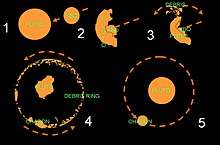
It is suspected that Pluto's satellite system was created by a massive collision, similar to the "big whack" thought to have created the Moon.[25][26] In both cases, the high angular momenta of the moons can only be explained by such a scenario. The nearly circular orbits of the smaller moons suggests that they were also formed in this collision, rather than being captured Kuiper Belt objects. This and their near orbital resonances with Charon (see below) suggest that they formed closer to Pluto than they are at present and migrated outward as Charon reached its current orbit. Their grey color is different from that of Pluto, one of the reddest bodies in the Solar System. This is thought to be due to a loss of volatiles during the impact or subsequent coalescence, leaving the surfaces of the moons dominated by water ice. However, such an impact should have created additional debris (more moons), yet no moons or rings were discovered by New Horizons, ruling out any more moons of significant size orbiting Pluto.
List
Pluto's moons are listed here by orbital period, from shortest to longest. Charon, which is massive enough to have collapsed into a spheroid at some point in its history, is highlighted in light purple. Pluto has been added for comparison.[15][27]
| Name (pronunciation) |
Image | Diameter (km) |
Mass (×1019 kg)[28] | Semi-major axis (km) |
Orbital period (days) |
Orbital period (relative to Charon) |
Eccentricity | Inclination (°) (to Pluto's equator) |
Magnitude (mean) | Discovery date | ||
|---|---|---|---|---|---|---|---|---|---|---|---|---|
| Pluto[29] | /ˈpluːtoʊ/ |  | 2372±4 | 1305±7 | 2035 | 6.387230 | 1 : 1 | 0.0022[lower-alpha 5] | 0.001 | 15.1 | 1930/02/18 | |
| Pluto I | Charon | /ˈʃærən/,[lower-alpha 6] /ˈkɛərən/ | .jpg) | 1208±3 | 158.7±1.5 | 17536±3* | 6.387230 | 1 : 1 | 0.0022[lower-alpha 5] | 0.001 | 16.8 | 1978/06/22 |
| Pluto V | Styx | /ˈstɪks/ | .jpg) | 16 × 9 × 8 ±?[30] | 0.00075 | 42656±78 | 20.16155±0.00027 | 1 : 3.16 | 0.0058 ± 0.0011 | 0.81 ± 0.16 | 27 | 2012/06/26 |
| Pluto II | Nix | /ˈnɪks/ |  | 50 × 35 × 33 ±?[30] | 0.005 ± 0.004 | 48694±3 | 24.85463±0.00003 | 1 : 3.89 | 0.002036 ± 0.000050 | 0.133 ± 0.008 | 23.7 | 2005/06/15 |
| Pluto IV | Kerberos | /ˈkɜːrbərəs/ /ˈkɜːrbəroʊs/ | .jpg) | 19 × 10 × 9[30] | 0.0016 ± 0.0009 | 57783±19 | 32.16756±0.00014 | 1 : 5.04 | 0.00328 ± 0.00020 | 0.389 ± 0.037 | 26 | 2011/06/28 |
| Pluto III | Hydra | /ˈhaɪdrə/ |  | 65 × 45 × 25 ±?[30] | 0.005 ± 0.004 | 64738±3 | 38.20177±0.00003 | 1 : 5.98 | 0.005862 ± 0.000025 | 0.242 ± 0.005 | 23.3 | 2005/06/15 |
- (*) All elements are with respect to the Pluto-Charon barycenter.[15] The maximum distance between the centers of Pluto and Charon is 19,571 ± 4 km.
Scale model of the Pluto system
 Pluto and its five moons, including the location of the system's barycenter. Sizes, distances and relative brightness of the bodies are to scale (click on image for detail).
Pluto and its five moons, including the location of the system's barycenter. Sizes, distances and relative brightness of the bodies are to scale (click on image for detail).
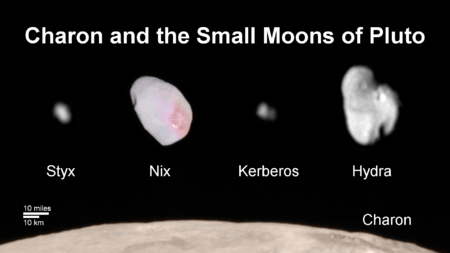
Mutual events
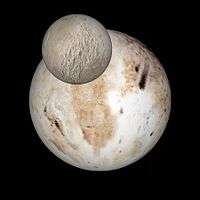
Transits occur when one of Pluto's moons passes between Pluto and the Sun. This occurs when one of the satellites' orbital nodes (the points where their orbits cross Pluto's ecliptic) lines up with Pluto and the Sun. This can only occur at two points in Pluto's orbit; coincidentally, these points are near Pluto's perihelion and aphelion. Occultations occur when Pluto passes in front of and blocks one of Pluto's satellites.
Charon has an angular diameter of 4 degrees of arc as seen from the surface of Pluto; the Sun appears much smaller, only 39 to 65 arcseconds. Charon's proximity further ensures that a large proportion of Pluto's surface can experience an eclipse. Because Pluto always presents the same face towards Charon due to tidal locking, only the Charon-facing hemisphere experiences solar eclipses by Charon.
The smaller moons can cast shadows elsewhere. The angular diameters of the four smaller moons (as seen from Pluto) are uncertain. Nix's is 3–9 minutes of arc and Hydra's is 2–7 minutes. These are much larger than the Sun's angular diameter, so total solar eclipses are caused by these moons.
Eclipses by Styx and Kerberos are more difficult to estimate, as both moons are very irregular, with angular dimensions of 76.9 x 38.5 to 77.8 x 38.9 arcseconds for Styx, and 67.6 x 32.0 to 68.0 x 32.2 for Kerberos. As such, Styx has no annular eclipses, its widest axis being more than 10 arcseconds larger than the Sun at its largest. However, Kerberos, although slightly larger, cannot make total eclipses as its largest minor axis is a mere 32 arcseconds. Eclipses by Kerberos and Styx will entirely consist of partial and hybrid eclipses, with total eclipses being extremely rare.
The next period of mutual events due to Charon will begin in October 2103, peak in 2110, and end in January 2117. During this period, solar eclipses will occur once each Plutonian day, with a maximum duration of 90 minutes.[31][32]
Exploration
The Pluto system was visited by the New Horizons spacecraft in July 2015. Images with resolutions of up to 330 meters per pixel were returned of Nix and up to 1.1 kilometers per pixel of Hydra. Lower-resolution images were returned of Styx and Kerberos.[33]
In science fiction
Author Edmond Hamilton referred to three moons of Pluto in his 1940 novel Calling Captain Future, naming them Charon, Styx, and Cerberus. Charon was listed as the largest of them. All three moons would not be discovered until the year 1970, according to Hamilton. The real Charon was discovered in 1978.[34]
Notes
- ↑ "P1P2_motion.avi". Archived from the original (AVI) on 4 November 2005. and barycenter for animations
- ↑ The ratio of 18:22:33 in the 3-body resonance corresponds to a 2-body resonance with ratio 2:3 between Hydra and Nix.
- ↑ The ratio of 18:22:33 in the 3-body resonance corresponds to a 2-body resonance with ratio 9:11 between Nix and Styx. In analogy, the ratio of 18:22:33 in the 3-body resonance corresponds to a 2-body resonance with ratio 6:11 between Hydra and Styx.
- ↑ This is calculated as follows: For every orbit of Hydra there are orbits of Nix and orbits of Styx. The conjunctions then occur at a relative rate of for Styx-Hydra, for Nix-Hydra and for Styx-Nix. Multiplying all three rates by (to make them integers) yields that there are Styx-Hydra conjunctions and Nix-Hydra conjunctions for every Styx-Nix conjunctions.
- 1 2 Orbital eccentricity and inclination of Pluto and Charon are equal because they refer to the same two-body problem (the gravitational influence of the smaller satellites is neglected here).
- ↑ Many astronomers use this, Christy's pronunciation, rather than the classical /ˈkɛərɒn/, but both are acceptable.
References
- ↑ "Moons dance around Pluto". Smithsonian Institution. 9 June 2015. Retrieved 9 April 2016.
- ↑ Green, Daniel W. E. (21 June 2006). "Satellites of Pluto". IAU Circular. 8723. Retrieved 26 November 2011. "NASA's Hubble Discovers Another Moon Around Pluto". NASA. 20 July 2011. Retrieved 20 July 2011.
- ↑ "Hubble Discovers a Fifth Moon Orbiting Pluto". hubblesite.org. 29 July 2012. Retrieved 2015-07-29.
- ↑ Staff (30 January 2014). "Barycenter". Education.com. Retrieved 4 June 2015.
- ↑ "The IAU draft definition of "planet" and "plutons"". International Astronomical Union. 16 August 2006. Retrieved 4 June 2015.
- ↑ "New Horizons 'Captures' Two of Pluto's Smaller Moons". New Horizons. Retrieved 2015-07-29.
- ↑ New Horizons Picks Up Styx
- ↑ Last of Pluto’s Moons – Mysterious Kerberos – Revealed by New Horizons
- 1 2 Stern, S. Alan; Weaver, Harold A., Jr.; Steffl, Andrew J.; et al. (2005). "Characteristics and Origin of the Quadruple System at Pluto". Submitted to Nature. arXiv:astro-ph/0512599. Bibcode:2005astro.ph.12599S.
- ↑ Steffl, A. J.; Mutchler, M. J.; Weaver, H. A.; Stern, S. A.; Durda, D. D.; Terrell, D.; Merline, W. J.; Young, L. A.; Young, E. F.; Buie, M. W.; Spencer, J. R. (2006). "New Constraints on Additional Satellites of the Pluto System". The Astronomical Journal. 132 (2): 614–619. arXiv:astro-ph/0511837. Bibcode:2006AJ....132..614S. doi:10.1086/505424.
- ↑ Kenyon, S. J. (2015-06-03). "Astronomy: Pluto leads the way in planet formation". Nature. 522 (7554): 40–41. Bibcode:2015Natur.522...40K. doi:10.1038/522040a. PMID 26040888.
- ↑ Stern, S. A.; Bagenal, F.; Ennico, K.; et al. (2015). "The Pluto system: Initial results from its exploration by New Horizons" (PDF). Science. 350 (6258): aad1815. arXiv:1510.07704. Bibcode:2015Sci...350.1815S. doi:10.1126/science.aad1815. PMID 26472913. (Supplements)
- ↑ "Orbits of 4 Bodies in Pluto System about Barycenter as Seen from Earth". Hubblesite. Retrieved 21 June 2006.
- ↑ Pasachoff, Jay M.; Babcock, Bryce A.; Souza, Steven P.; et al. (2006). "A Search for Rings, Moons, or Debris in the Pluto System during the 2006 July 12 Occultation". Bulletin of the American Astronomical Society. 38 (3): 523. Bibcode:2006DPS....38.2502P.
- 1 2 3 4 5 6 7 8 Showalter, M. R.; Hamilton, D. P. (3 June 2015). "Resonant interactions and chaotic rotation of Pluto's small moons". Nature. 522 (7554): 45–49. Bibcode:2015Natur.522...45S. doi:10.1038/nature14469. PMID 26040889.
- ↑ Codex Regius (2016). Pluto & Charon. XinXii. p. 197. ISBN 9781534633520. Retrieved 13 March 2018.
- ↑ Witze, Alexandra (2015). "Pluto's moons move in synchrony". Nature. doi:10.1038/nature.2015.17681.
- ↑ Matson, J. (11 July 2012). "New Moon for Pluto: Hubble Telescope Spots a 5th Plutonian Satellite". Scientific American web site. Retrieved 12 July 2012.
- ↑ Lithwick, Y.; Y. Wu (2008). "On the Origin of Pluto's Minor Moons, Nix and Hydra". arXiv:0802.2951 [astro-ph].
- ↑ Chang, Kenneth (3 June 2015). "Astronomers Describe the Chaotic Dance of Pluto's Moons". New York Times. Retrieved 4 June 2015.
- ↑ "NASA's Hubble Finds Pluto's Moons Tumbling in Absolute Chaos". Retrieved 3 June 2015.
- ↑ "Hubble Finds Two Chaotically Tumbling Pluto Moons". hubblesite.org. 3 June 2015. Retrieved 3 June 2015.
- 1 2 Drake, Nadia; 03, National Geographic Published June. "Pluto's Moons Dance to a Random Beat". National Geographic News. Retrieved 4 June 2015.
- ↑ Ragozzine, Darin (17 October 2016). "Rapidly Rotating Regular Satellites and Tides". Planetary Society. Retrieved 12 September 2017.
- ↑ Canup, R. M. (8 January 2005). "A Giant Impact Origin of Pluto-Charon". Science. 307 (5709): 546–550. Bibcode:2005Sci...307..546C. doi:10.1126/science.1106818. PMID 15681378. Retrieved 2011-07-20.
- ↑ Stern, S. A.; Weaver, H. A.; Steff, A. J.; Mutchler, M. J.; Merline, W. J.; Buie, M. W.; Young, E. F.; Young, L. A.; Spencer, J. R. (23 February 2006). "A giant impact origin for Pluto's small moons and satellite multiplicity in the Kuiper belt" (PDF). Nature. 439 (7079): 946–948. Bibcode:2006Natur.439..946S. doi:10.1038/nature04548. PMID 16495992. Archived from the original (PDF) on 19 January 2012. Retrieved 20 July 2011.
- ↑ Orbital elements of small satellites from Showalter and Hamilton, 2015; mass and magnitude from Buie & Grundy, 2006
- ↑ "(134340) Pluto, Charon, Nix, Hydra, Kerberos, and Styx". www.johnstonsarchive.net. Retrieved 2018-06-22.
- ↑ Pluto data from D. R. Williams (7 September 2006). "Pluto Fact Sheet". NASA. Retrieved 24 March 2007. .
- 1 2 3 4 Weaver et al. (2016)
- ↑ "Start of Eclipse". JPL Solar System Simulator. 12 December 1987. Retrieved 2014-07-29. (Pluto as seen from the Sun during mid-eclipse)
- ↑ "End of Eclipse". JPL Solar System Simulator. 12 December 1987. Retrieved 2014-07-29.
- ↑ New Horizons flyby timeline
- ↑ Codex Regius (2016). Pluto & Charon. CreateSpace Independent Publishing Platform. ISBN 978-1534960749.
Sources
- S.A. Stern, H.A. Weaver, A.J. Steffl, M.J. Mutchler, W.J. Merline, M.W. Buie, E.F. Young, L.A. Young, & J.R. Spencer (2006), Characteristics and Origin of the Quadruple System at Pluto, Nature, submitted (preprint)
- Steffl, A. J.; Mutchler, M. J.; Weaver, H. A.; Stern, S. A.; Durda, D. D.; Terrell, D.; Merline, W. J.; Young, L. A.; Young, E. F.; Buie, M. W.; Spencer, J. R. (2006). "New Constraints on Additional Satellites of the Pluto System". The Astronomical Journal. 132 (2): 614–619. arXiv:astro-ph/0511837. Bibcode:2006AJ....132..614S. doi:10.1086/505424.
- Buie M.W., Grundy W.M., Young, E.F., Young L.A., Stern S.A. (2005), Orbits and photometry of Pluto's satellites: Charon, S/2005 P1 and S/2005 P2, submitted (preprint)
- Brozovic, M., Showalter, M. R., Jacobson, R. A., & Buie, M. W. (2015), The orbits and masses of satellites of Pluto, Icarus, 246, 317. doi:10.1016/j.icarus.2014.03.015 Bibcode: 2015Icar..246..317B
- Codex Regius (2016), Pluto & Charon, CreateSpace Independent Publishing Platform ISBN 978-1534960749
- IAU Circular No. 8625, describing the discovery of 2005 P1 and P2
- IAU Circular No. 8686, reporting a more neutral color for 2005 P2
- IAU Circular No. 8723 announcing the names of Nix and Hydra
- Background Information Regarding Our Two Newly Discovered Satellites of Pluto – The website of the discoverers of Nix and Hydra
External links
| Wikimedia Commons has media related to Moons of Pluto. |
